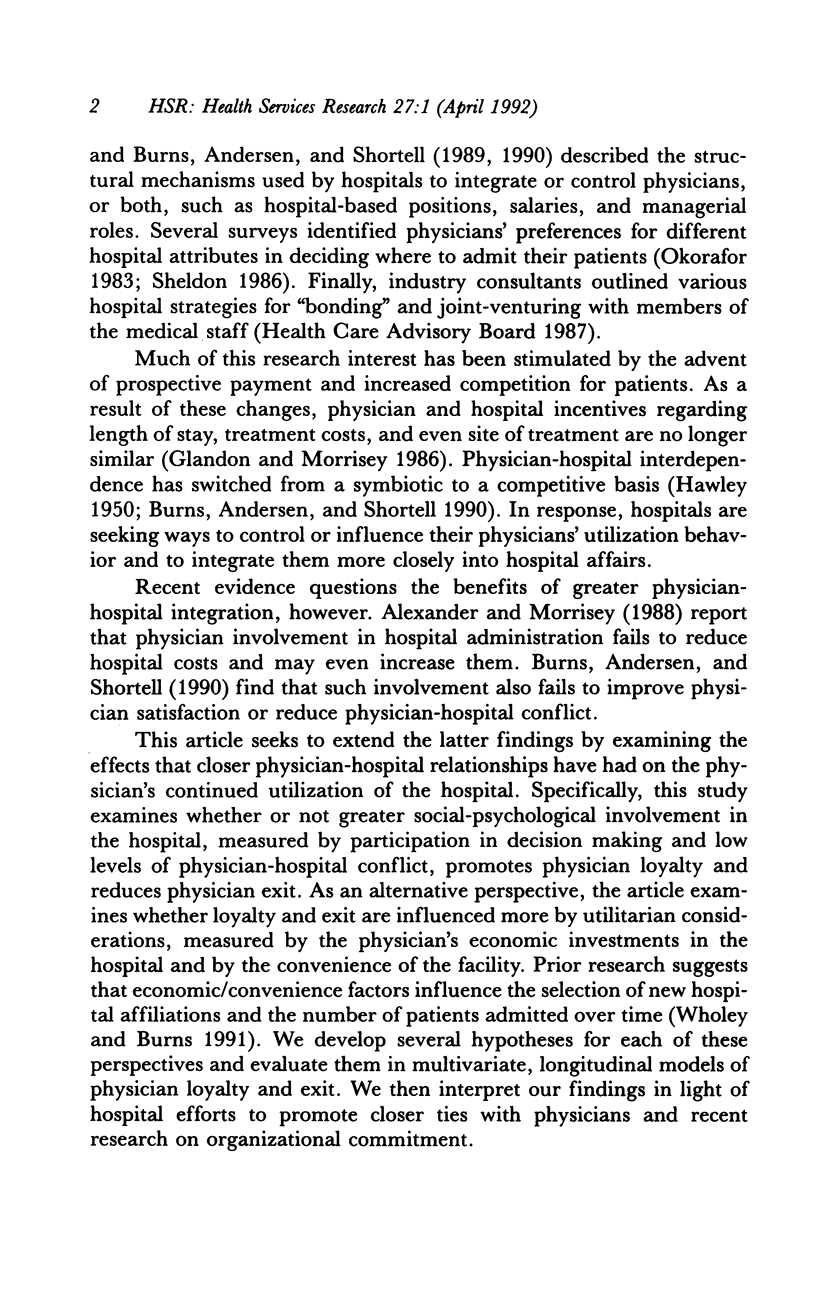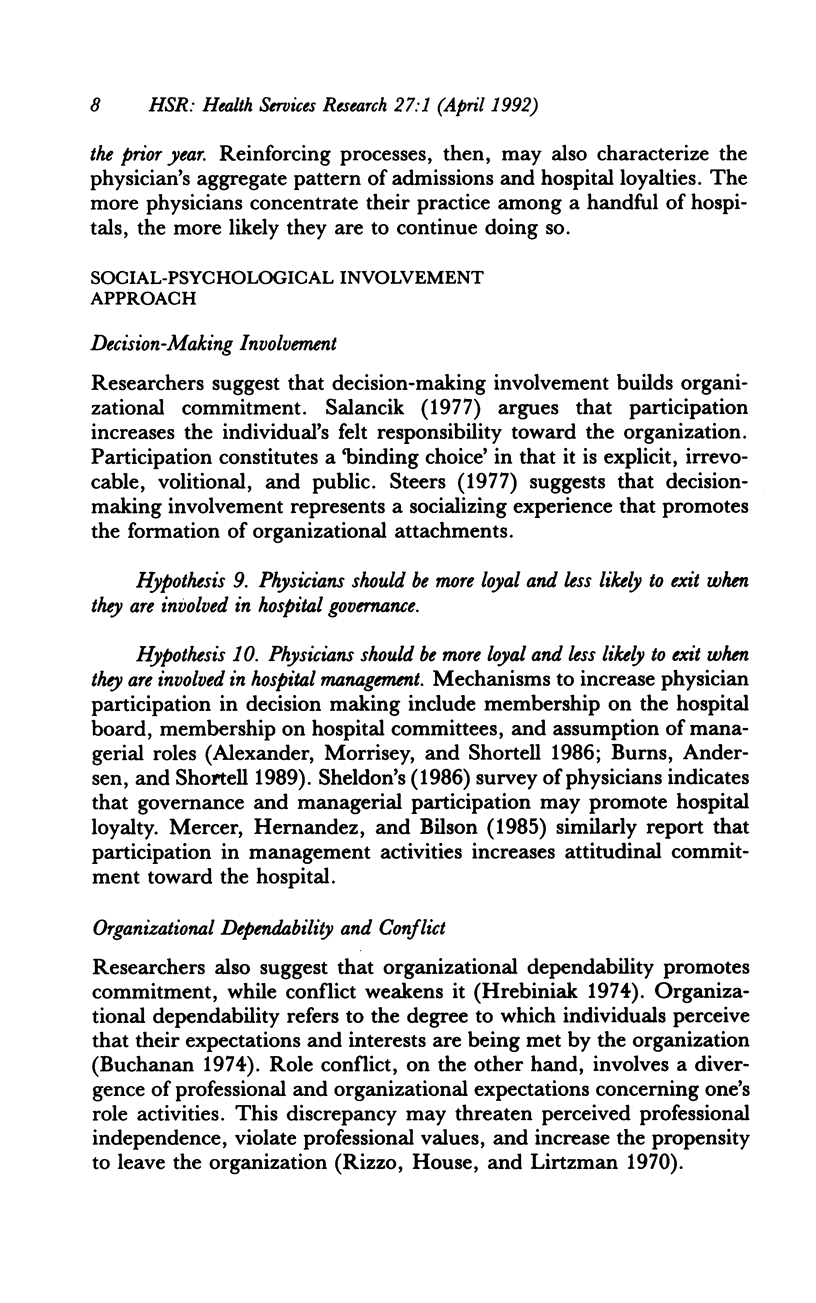Abstract
This article examines forces that influence physicians to change the percentage of their admissions to a hospital (loyalty) and to cease admitting patients to a hospital altogether (exit). Because physicians are both members of a hospital and consumers of its services, their admitting patterns can be described using models of employee commitment and consumer buying behavior. We test several hypotheses drawn from these literatures using data on physician admissions at hospitals over a two-year period. Results indicate that admitting patterns are explained primarily by convenience and inertia processes characteristic of consumer behavior. On the other hand, factors believed to influence organizational commitment (e.g., decision-making involvement, conflict, economic investments) have little effect on loyalty and exit. The findings question the utility of hospital strategies to improve the climate of physician-hospital relations, and suggest several qualifications for research on the commitment of professionals.
Full text
PDF























Selected References
These references are in PubMed. This may not be the complete list of references from this article.
- Alexander J. A., Morrisey M. A. Hospital-physician integration and hospital costs. Inquiry. 1988 Fall;25(3):388–401. [PubMed] [Google Scholar]
- Alexander J. A., Morrisey M. A., Shortell S. M. Effects of competition, regulation, and corporatization on hospital-physician relationships. J Health Soc Behav. 1986 Sep;27(3):220–235. [PubMed] [Google Scholar]
- Burns L. R., Andersen R. M., Shortell S. M. The effect of hospital control strategies on physician satisfaction and physician-hospital conflict. Health Serv Res. 1990 Aug;25(3):527–560. [PMC free article] [PubMed] [Google Scholar]
- Burns L. R., Andersen R. M., Shortell S. M. The impact of corporate structures on physician inclusion and participation. Med Care. 1989 Oct;27(10):967–982. doi: 10.1097/00005650-198910000-00007. [DOI] [PubMed] [Google Scholar]
- Burns L. R., Wholey D. R., Huonker J. Physician use of hospitals: effects of physician, patient, and hospital characteristics. Health Serv Manage Res. 1989 Nov;2(3):191–203. doi: 10.1177/095148488900200303. [DOI] [PubMed] [Google Scholar]
- Glandon G. L., Morrisey M. A. Redefining the hospital-physician relationship under prospective payment. Inquiry. 1986 Summer;23(2):166–175. [PubMed] [Google Scholar]
- Luft H. S., Garnick D. W., Mark D. H., Peltzman D. J., Phibbs C. S., Lichtenberg E., McPhee S. J. Does quality influence choice of hospital? JAMA. 1990 Jun 6;263(21):2899–2906. [PubMed] [Google Scholar]
- Mick S. S., Sussman S., Anderson-Selling L., DelNero C., Glazer R., Hirsch E., Rowe D. S. Physician turnover in eight New England prepaid group practices: an analysis. Med Care. 1983 Mar;21(3):323–337. doi: 10.1097/00005650-198303000-00005. [DOI] [PubMed] [Google Scholar]
- Okorafor H. Hospital characteristics attractive to physicians and the consumers: implications for public general hospitals. Hosp Health Serv Adm. 1983 Mar-Apr;28(2):50–65. [PubMed] [Google Scholar]
- Scott W. R. Managing professional work: three models of control for health organizations. Health Serv Res. 1982 Fall;17(3):213–240. [PMC free article] [PubMed] [Google Scholar]
- Shortell S. M. The medical staff of the future: replanting the garden. Front Health Serv Manage. 1985 Feb;1(3):3–48. [PubMed] [Google Scholar]
- Steers R. M. Antecedents and outcomes of organizational commitment. Adm Sci Q. 1977 Mar;22(1):46–56. [PubMed] [Google Scholar]
- Stevens J. M., Beyer J. M., Trice H. M. Assessing personal, role, and organizational predictors of managerial commitment. Acad Manage J. 1978 Sep;21(3):380–396. [PubMed] [Google Scholar]
- Wholey D. R., Burns L. R. Convenience and independence: do physicians strike a balance in admitting decisions? J Health Soc Behav. 1991 Sep;32(3):254–272. [PubMed] [Google Scholar]


